
In order to stay competitive, auto companies constantly have to launch new features to move their latest models. But in many cases, we're experiencing a Groundhog Day-like scenario whereby some of these new fads are not really new. Even though auto marketers want you to think the following technologies are new and innovative, check out where they came from.
The Electric Engine
Then: Putting an electric motor into a car as a method of propulsion is not new. In fact, electric cars have been around since 1897, though some credit Robert Anderson for their creation in 1839. The problem with using electric motors, however, has been mostly due to limitations in battery technology. The MK III, by Pope Manufacturing, could operate at 12 mph for a maximum of 30 miles before its 40-cell battery needed recharging. In addition to its short range, another drawback of this early model was the weight of the motor: 120 pounds. Though heavy, the Pope model was slight in contrast to the 315-pound "motor cycle" produced in 1888 by Andrew Riker.
Now: Battery technology has improved enormously in recent decades, because every electronic product has a battery in it, and electronics consumers demand greater efficiency before they shell out their hard-earned dollars for new models. Today, lithium-ion polymer batteries can take electric cars up to 200 miles without a recharge. Soon, silicon anodes, much more conductive than the graphite anodes of today's lithium-ion batteries, may lead to a full day of laptop or electric car battery life. The improved longevity of batteries has spurred companies into developing "new" electric cars that also, thankfully, look a lot cooler than the one above.
Then, and now, electric cars have issues, like the expense of replacing a battery cell (approximately $12,000), the range of an electric car before it needs recharging (approximately 200 miles, depending upon car brand and battery type) and the longevity of a charge in a sitting car, which can be greatly affected by external temperatures. Cold climates can degrade range by 30 percent.
A Car That Flies
Then: Way back in 1916, the U.S. patent office first issued a patent for a vehicle that was capable of both driving on roadways and soaring through the air. One of the problems involved removing the wings and transforming the flying machine into something that could safely travel down the narrow roads of yesteryear, which severely limited the commercial appeal for such a contraption.
Now: Folding-wing technology has allowed for a crossbreed car-plane in recent years. In 2008, a machine called the Transition, created by a group of MIT alumni, started flight tests. The plan is to offer the Transition to driving/flying enthusiasts as a consumer product, once the FAA has approved it. According to CBS News, the Pentagon is also developing prototypes for flying/driving vehicles that will be ready for testing by 2015.
Wider roadways, along with the military's need for innovative vehicles, have led to the recycled idea of flying cars. Whether the rabble will have access to flying cars, like the Jetsons', is debatable due to high costs, flight regulations and international security.
The Hybrid Car
Then: With the advent of the electric motor, engineers were able to create the first hybrids by pairing a motor with a small gasoline engine. Porsche developed the first hybrid powertrain in 1898, which was followed by Pope's model in 1899. These cars could typically drive 40 miles on a 40-cell battery before the hybrids were manually switched to gasoline power. In another hybrid patented by Henri Pieper, the driver had to switch between hybrid and gas modes using a lever and a clutch. And you thought that a manual transmission was challenging!
Now: Back in the 1890s, they didn't use a fancy name like "hybrid" to describe the vehicle, but the concept was the same. Today's models are able to automatically shift from battery to gas power, depending upon which method is more efficient (as determined by the computer in your car). Though electric cars leave a smaller carbon footprint, hybrid vehicles strike a balance between eco-efficiency and range.
The Car-Boat
Then: At first thought, the idea of a car-boat sounds like, well, a watery proposition. Engineers have been trying to create a vehicle that can successfully transition from a body of water to dry land for years. The problem has been that the parts involved in such a machine need to be extremely hardy in order to handle the two opposite conditions. In the past, such machines have been highly susceptible to rust, leakage and other degrees of wear.
Now: Although the concept has been around for decades, it hasn't really been perfected. Now, a company called Rinspeed is taking the idea to the extreme by allowing people to not only have a car that drives on dry road, but that can be fully submerged. It's called the sQuba and it costs $1.5 million. It's probably not easy to get car insurance for the sQuba, but on the bright side, you could always insure it as a boat. The idea of car-boats is so seductive that the BBC has developed a hit program that features young engineers who create designs like the "Toybota," and then tests the new vehicles. Though Toybota sank, a sailing Porsche has proven that hope floats, and consumer curiosity rules the market.
Car-boats may prove as useful as Ron Popeil products, so the consumer-driven development of car-boats may yet lead to a success story. Whether fully submerged or floating aloft precariously, car-boats are at least more fun than the other alternatives.
From innovations of the 1890s to the trends of today, transportation seems to be fueled by a regeneration of ideas rather than novel concepts. In order to keep their latest models in demand, expect retailers to at least be industrious about their marketing tactics. For 2011, expect a plethora of new flashy gadgets and rumors of future ingenuity.